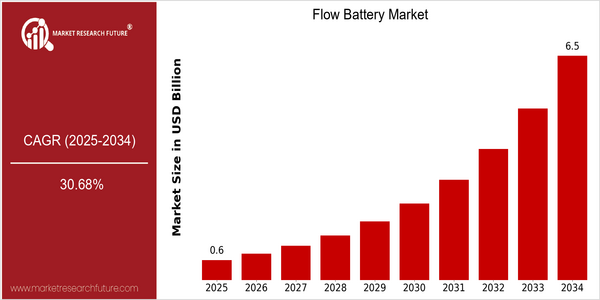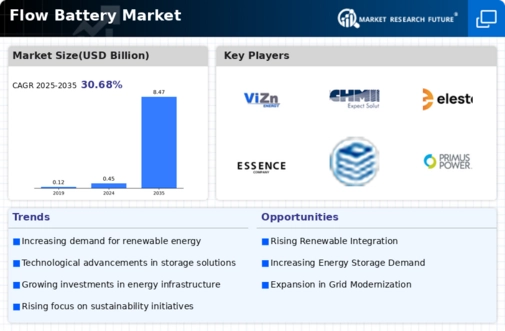Flow Battery Size
Market Size Snapshot
| Year | Value |
|---|---|
| 2025 | USD 0.58 Billion |
| 2034 | USD 6.48 Billion |
| CAGR (2025-2034) | 30.68 % |
Note – Market size depicts the revenue generated over the financial year
The market for flow batteries is growing rapidly. From a size of $58 million in 2025, it is expected to reach $6.4 billion by 2034. The compound annual growth rate (CAGR) for this remarkable growth is 30.68%. Such growth reflects the rising demand for energy storage devices, particularly in the context of the integration of renewable energy and the stability of the grid. Flow batteries are becoming more and more important because of their scalability, long cycle life and the fact that they can store large amounts of energy. The market is also growing due to technological progress, falling material costs and increasing investment in the renewable energy sector. Flow batteries are being developed with all-vanadium and zinc-bromine systems. These are improving their performance and efficiency, which is making them more attractive for commercial and industrial applications. Redflow, ViZn Energy and Lockheed Martin are pursuing strategic initiatives, including strategic alliances and product launches, in order to capture the market. Redflow is concentrating on increasing its production capacity, while ViZn Energy is developing its technology to improve the energy density and reduce costs, thus strengthening its position as a leader in the field of flow batteries.

Regional Market Size
Regional Deep Dive
The Flow Battery Market is growing at a considerable pace in several regions, driven by the rising demand for energy storage solutions and the transition to renewable energy sources. The market in North America is characterized by a strong focus on technological innovation and government support for clean energy initiatives. In Europe, the investment in renewable energy is increasing. Asia-Pacific is experiencing a rapid uptake of flow batteries due to their scalability and efficiency. The Middle East and Africa are beginning to explore flow batteries as a viable energy storage solution, especially for off-grid applications. Latin America is also becoming an important market, with several countries focusing on sustainable energy solutions to meet their growing energy needs.
Europe
- The European Union has set ambitious targets for carbon neutrality by 2050, leading to increased funding for energy storage projects, including flow batteries, to support renewable energy sources.
- Notable projects, such as the 'Flow Battery Project' in Germany, are demonstrating the effectiveness of flow batteries in stabilizing the grid and providing backup power, which is influencing policy and investment decisions across the region.
Asia Pacific
- China is rapidly expanding its flow battery production capabilities, with companies like Rongke Power investing heavily in research and development to enhance battery performance and reduce costs.
- Australia is witnessing a growing interest in flow batteries, particularly in remote areas, as the government promotes energy storage solutions to support its renewable energy targets and reduce reliance on fossil fuels.
Latin America
- Brazil is investing in flow battery technology as part of its efforts to modernize its energy infrastructure and integrate more renewable sources into its grid.
- Chile's government is promoting energy storage solutions, including flow batteries, to support its ambitious renewable energy goals, which could lead to increased adoption in the region.
North America
- The U.S. Department of Energy has launched initiatives to promote advanced energy storage technologies, including flow batteries, which are expected to enhance grid reliability and support renewable energy integration.
- Companies like ESS Inc. and Redflow are making strides in the North American market, with ESS Inc. recently securing contracts for large-scale flow battery installations, showcasing the growing confidence in this technology.
Middle East And Africa
- Countries like the United Arab Emirates are exploring flow battery technology as part of their broader strategy to diversify energy sources and enhance energy security, particularly in off-grid applications.
- The African Development Bank is funding projects that incorporate flow batteries to improve energy access in rural areas, highlighting the potential for this technology to address energy poverty in the region.
Did You Know?
“Flow batteries can provide energy storage for up to 20 years, significantly longer than traditional lithium-ion batteries, making them a sustainable choice for long-term energy solutions.” — International Renewable Energy Agency (IRENA)
Segmental Market Size
The flow battery market is growing fast, mainly due to the increasing demand for storage solutions in the field of renewable energy. The increasing need for grid stability caused by the growing penetration of intermittent sources such as wind and solar energy is one of the main drivers. The other is the implementation of energy policies that encourage the use of clean energy. Also, the technological developments in flow batteries, such as zinc-bromine and vanadium flow batteries, have increased their popularity because of their high efficiency and long service life. The current phase of flow batteries is the transition from pilot to commercial projects. The notable examples are the installation of vanadium flow batteries by Invinity Energy in the United Kingdom and the state of California in the United States. The main application areas are large-scale energy storage, microgrids and the integration of renewable energy. Flow batteries are used to provide reliable backup power and load shifting. Among the trends driving growth are government regulations, carbon-neutrality initiatives and green growth. In addition, the innovations in the field of battery management systems and materials science are influencing the evolution of the market.
Future Outlook
The flow battery market is expected to grow at a CAGR of 30.68 % from 2025 to 2035. This growth is driven by the increasing demand for energy storage solutions, which is in turn driven by the transition to renewable energy sources. As countries strive to reduce their CO2 emissions, flow batteries are increasingly becoming an alternative for large-scale energy storage, especially in grid stability and integration of renewable energy. By 2035, it is expected that flow batteries will represent approximately 15 - 20 % of the total energy storage market, significantly increasing their penetration in both commercial and utility-scale applications. Several technological improvements, including the chemistry and efficiency of the batteries, will also contribute to market growth. Flow batteries, especially vanadium flow batteries and organic flow batteries, are expected to increase their energy density and reduce their cost, enabling them to compete more effectively with lithium-ion batteries. Moreover, the support and incentives of governments to promote clean energy are expected to play a key role in increasing the rate of penetration. Also, the increasing development of micro-grids and the growing importance of energy resilience to climate change will also play an important role in the development of flow batteries. Hence, the future of the flow battery market is promising.











Leave a Comment